udra
Introduction
I have been covering Apple Inc. (NASDAQ:AAPL) stock here on Seeking Alpha since mid-December 2021. I have remained Neutral ever since, constantly saying that despite the apparent moat and free cash flow (“FCF”) generation that the company has continued to please shareholders through challenging times, the stock seemed overpriced – both in terms of its historical multiples and in comparison with the entire IT sector.
In my last article – “Why Apple’s Moonshot Is Unlikely In 2023” – I wrote about the risk of a demand disruption threatening the company:
I think the price elasticity of demand for Apple’s products – despite all the brand power – is seriously threatened now and especially next year. In Europe, on which 24.1% of Apple’s total revenue depends [as of FY2022], gas and electricity bills have risen by double, so amid China (18% of AAPL’s revenue) where the situation looks no better in its own way, I expect a demand disruption, which to date is difficult to track using just lead times.
As time has shown, this risk has gradually materialized – I will discuss the latest news and its potential impact in today’s article.
Lower Prices + Lower Volumes = Further EPS Downward Revisions
On Dec. 30, WCCFTech published an article stating that Apple is considering a price cut for next year’s iPhone 15 and the larger iPhone 15 Plus due to lower demand for the iPhone 14 and its “Plus” variant.
In the most recent reporting quarter, Apple generated around 52% of its total revenue from iPhones in FY2022, according to the company’s 10-K – it’s not entirely clear how much of that revenue came from the iPhone 14 and iPhone 14 Plus models, so it’s complicated to make any clear inferences about the impact of a possible price reduction only in 2 categories. However, by analogy with FY2022, 2 categories make up 50% of this segment’s total assortment, so I think the price cut – in case it takes place – will hit the first part of the sales equation pretty hard (price multiple by total volume = total sales).
The fact that Apple is having certain problems with sales of the “Plus” models has been discussed for a few months. However, few say that the company will likely be forced to lower prices not only for “Plus,” but also for the flagship model. For example, if Apple lowers the price of the iPhone 15 Plus to $800, the standard iPhone 15 would probably also cost $800 – this means the price of the iPhone 15 would have to be lowered to $700 to keep a price difference between the two models, like the iPhone 13 mini and the standard iPhone 13.
From this example, we can see how disinflationary processes, which the market was so deliriously happy about not long ago, can be disastrous for large companies that have continued to accumulate a “high base” and that find not only a slowdown in sales growth but its absence in times of declining demand.
Even if Apple does not have to lower its prices, the decline in manufactured products – Nikkei Asia reported this a few hours ago – will also lead to a drop in revenue and EPS.
As I wrote earlier, the company’s products are quite price elastic – so the risk cannot be ruled out that Apple will have to reduce production volumes against the backdrop of lower selling prices. If this risk materializes, the stock will most likely continue to plummet.
Analysts still do not believe the company will see a decline in revenue and earnings per share in FY2023 – according to 38 Wall Street professionals, Apple and ESP revenue will increase by 2.66% and 1.19% (year-over-year), respectively. Moreover, FY2024 will be a pronounced recovery period, and in 2028 we will see growth rates that are more than 2x the long-term averages (according only to 1 analyst):
Author’s Excel calculations, Seeking Alpha data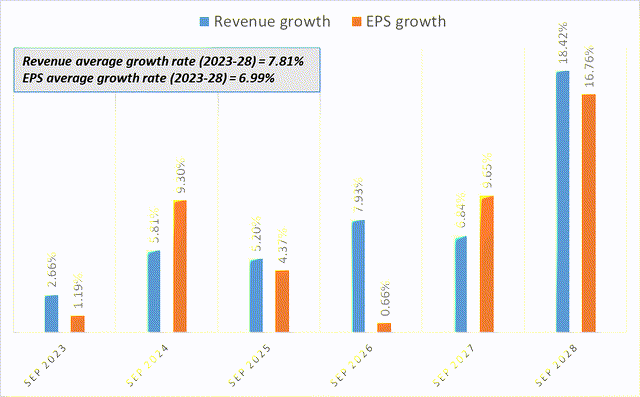
How the company will be able to achieve these goals given the demand dynamics is not entirely clear to me. I think that despite the 37 downward EPS revisions [over the past 3 months], the Street is still too positive about the company’s medium-term prospects.
Everything looks like no one is learning the lessons of the past, of which there are many. I suggest that you look at some of them.
In 2016, Apple also faced a decline in demand for its products. At the time, revenue and EPS were down 7.7% and 9.9%, respectively (YoY) and the EBIT margin was down 27 basis points, according to ROIC.ai. At the time, the company was trading at an average price-to-earnings ratio of 12.4x, which was about 0.6 times the P/E ratio of the S&P 500 Index then.
A fresher example is 2019, when the company’s revenue and earnings per share declined 2% and 9.8% (YoY), respectively, while the EBIT margin declined 21 basis points. Fortunately, this year [FY2019] is included in Argus Research‘s analytical table with all the average key multiples for this period:
Argus Equity Research, AAPL, author’s notes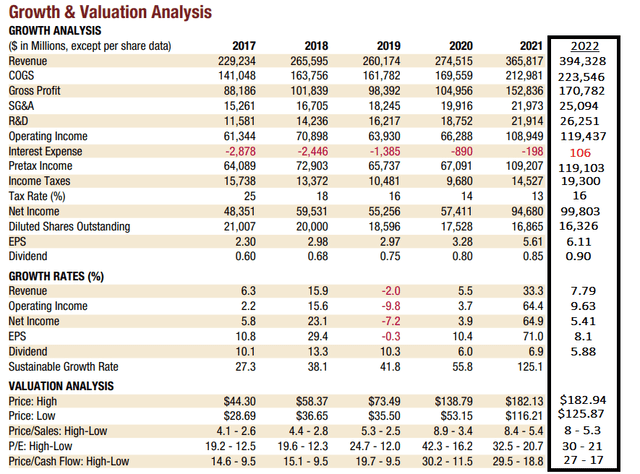
AAPL’s average price-to-earnings ratio in 2019 was 17.3x, which was about 0.7 times the S&P 500 Index at the time.
And what do we see in 2022?
Apple’s stock is currently being traded at a significant premium compared to its 2016 and 2019 multiples, ranging from 15-30% depending on the specific multiple used for comparison.
With the corporate growth analysts predict for the next year, AAPL cannot justify such high multiples – no matter how huge its moat. This is made clear by the excess in the PEG ratios:
Seeking Alpha, AAPL’s Valuation, author’s notes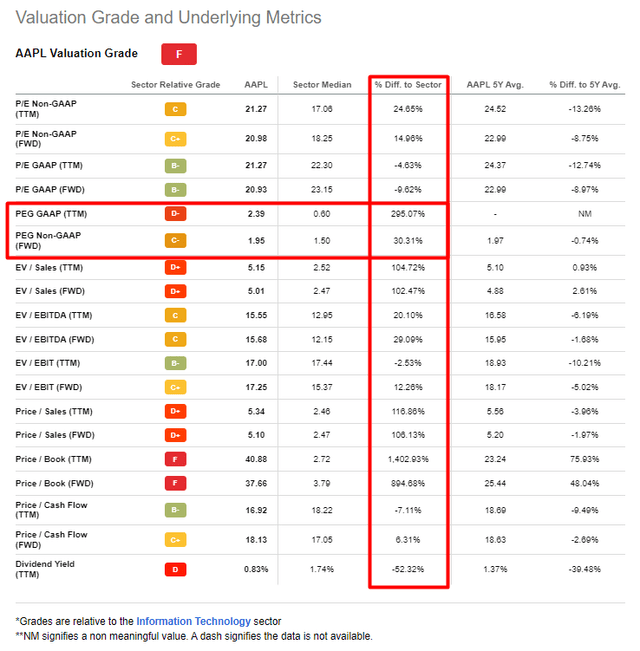
And while we are on the subject of business valuation, let’s try to model out analysts’ expectations. I take the consensus forecasts and simply input them into a DCF model. Here, I assume that EBIT and EBITDA margins will again fall slightly in FY2023 (27% and 30%), but recover in 2024 and come close to previous years’ records again at the end of the forecast period (FY2027 – 31% and 33%).
The ratio of CAPEX to sales will fall slightly to 3% in FY2023 – I expect the capital allocation to be more conservative amid all the difficulties. From 2024, the company will return to its usual average of 3.5%.
The WACC is somewhat difficult to calculate – this is a fairly subjective category that involves a whole set of unreliable assumptions. I assume a risk-free rate of 3.7% (10-year US bonds), with a market risk premium of 4.7%. With a beta of 1.2, we get a WACC of 9.1%, which I consider reasonable.
Based on this, here is what the root conclusions of the model look like:
Stratoshere.io, author’s inputs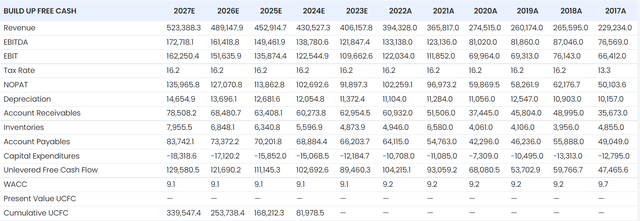
Assuming long-term corporate growth (Gordon’s g model) of 3%, we get an equity value (net of net debt) of $1,799 billion – about $110.2 per share. So even against the backdrop of quite optimistic forecasts, we get an overvaluation of about 12% compared to yesterday’s closing price.
Stratoshere.io, author’s inputs
I suspect that this downside potential could be even bigger if the actual sales and EPS figures cannot keep up with what is currently priced in.
Risks to my findings
AAPL relatively outperformed its peers during the tech sector selloff in 2022, although the stock is still in the red. In 2021, AAPL posted a rare sector-matching performance in line with the sector. For many years, the company has been a “last resort” for those who want to buy shares but do not want to take on too much risk – resulting in a premium that may stay with AAPL longer than logic tells me. This is definitely a risk to my entire finding on Apple’s overvaluation.
Furthermore, the stock is now >31% off its local multi-month high, which could indirectly indicate that AAPL has priced in all the negativity described above.
Another risk is the reliability of the information that the company is seriously considering lowering the price of its flagship 15 series products. This information is not official – it was shared by Yyeux1122 on Naver. Previously, this user had leaked information that accurately predicted the price of the iPhone 14 Pro, the chip and colors of the iPhone 14 Pro, and the design changes and release date of the tenth-generation iPad. However, now there is a possibility that the new leak does not match the reality.
Summary Thesis
Based on the foregoing, I conclude that the potential price cut for iPhone 15, as well as the decline in sales volumes, should eventually lead to the multiple contraction I so often mention in my articles about Apple. This conclusion is supported by DCF simulations, according to which AAPL still appears too expensive [despite its moat] even with fairly optimistic consensus forecasts. I am sure that the company can overcome major difficulties thanks to its unique advantage described by Jim Kelleher, CFA from Argus Research: a perpetually refreshed roster of highly desirable products. But this does not mean at all that you have to buy AAPL here and now – we may see much more attractive entry points in the future. So I remain Neutral and set a price target of $110 per share sometime in 2023. And the ugly-looking AAPL’s stock chart concurs with my thesis:
TrendSpider, AAPL weekly, author’s notes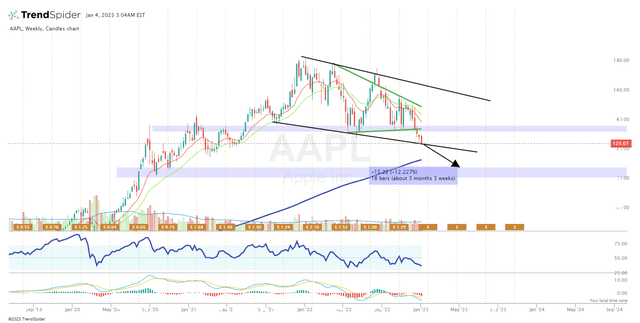
Thanks for reading!




